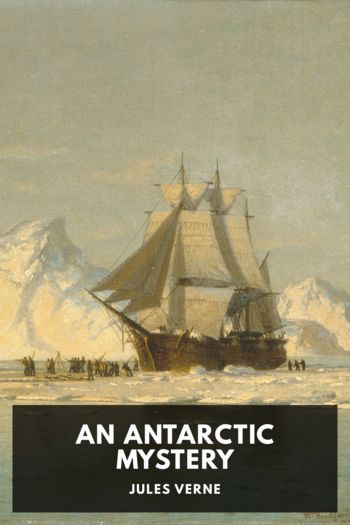Round the Moon by Jules Verne (read aloud txt) 📕

- Author: Jules Verne
Book online «Round the Moon by Jules Verne (read aloud txt) 📕». Author Jules Verne
Islands are numerous on the surface of the moon. They are almost all oblong or circular, as though traced with a compass, and seem to form a vast archipelago, like that charming group lying between Greece and Asia Minor which mythology formerly animated with its most graceful legends. Involuntarily the names of Naxos, Tenedos, Milo, and Carpathos come into the mind, and you seek the ship of Ulysses or the “clipper” of the Argonauts. That was what it appeared to Michel Ardan; it was a Grecian Archipelago that he saw on the map. In the eyes of his less imaginative companions the aspect of these shores recalled rather the cut-up lands of New Brunswick and Nova Scotia; and where the Frenchman looked for traces of the heroes of fable, these Americans were noting favourable points for the establishment of mercantile houses in the interest of lunar commerce and industry.
Some remarks on the orographical disposition of the moon must conclude the description of its continents, chains of mountains, isolated mountains, amphitheatres, and watercourses. The moon is like an immense Switzerland—a continual Norway, where Plutonic influence has done everything. This surface, so profoundly rugged, is the result of the successive contractions of the crust while the orb was being formed. The lunar disc is propitious for the study of great geological phenomena. According to the remarks of some astronomers, its surface, although more ancient than the surface of the earth, has remained newer. There there is no water to deteriorate the primitive relief, the continuous action of which produces a sort of general levelling. No air, the decomposing influence of which modifies orographical profiles. There Pluto’s work, unaltered by Neptune’s, is in all its native purity. It is the earth as she was before tides and currents covered her with layers of soil.
After having wandered over these vast continents the eye is attracted by still vaster seas. Not only does their formation, situation, and aspect recall the terrestrial oceans, but, as upon earth, these seas occupy the largest part of the globe. And yet these are not liquid tracts, but plains, the nature of which the travellers hoped soon to determine.
Astronomers, it must be owned, have decorated these pretended seas with at least odd names which science has respected at present. Michel Ardan was right when he compared this map to a “map of tenderness,” drawn up by Scudery or Cyrano de Bergerac.
“Only,” added he, “it is no longer the map of sentiment like that of the 18th century; it is the map of life, clearly divided into two parts, the one feminine, the other masculine. To the women, the right hemisphere; to the men, the left!”
When he spoke thus Michel made his prosaic companions shrug their shoulders. Barbicane and Nicholl looked at the lunar map from another point of view to that of their imaginative friend. However, their imaginative friend had some reason on his side. Judge if he had not.
In the left hemisphere stretches the “Sea of Clouds,” where human reason is so often drowned. Not far off appears the “Sea of Rains,” fed by all the worries of existence. Near lies the “Sea of Tempests,” where man struggles incessantly against his too-often victorious passions. Then, exhausted by deceptions, treasons, infidelities, and all the procession of terrestrial miseries, what does he find at the end of his career? The vast “Sea of Humours,” scarcely softened by some drops from the waters of the “Gulf of Dew!” Clouds, rain, tempests, humours, does the life of man contain aught but these? and is it not summed up in these four words?
The right-hand hemisphere dedicated to “the women” contains smaller seas, the significant names of which agree with every incident of feminine existence. There is the “Sea of Serenity,” over which bends the young maiden, and the “Lake of Dreams,” which reflects her back a happy future. The “Sea of Nectar,” with its waves of tenderness and breezes of love! The “Sea of Fecundity,” the “Sea of Crises,” and the “Sea of Vapours,” the dimensions of which are, perhaps, too restricted, and lastly, that vast “Sea of Tranquillity” where all false passions, all useless dreams, all unassuaged desires are absorbed, and the waves of which flow peacefully into the “Lake of Death!”
What a strange succession of names! What a singular division of these two hemispheres of the moon, united to one another like man and woman, and forming a sphere of life, carried through space. And was not the imaginative Michel right in thus interpreting the fancies of the old astronomers?
But whilst his imagination thus ran riot on the “seas,” his grave companions were looking at things more geographically. They were learning this new world by heart. They were measuring its angles and diameters.
To Barbicane and Nicholl the “Sea of Clouds” was an immense depression of ground, with circular mountains scattered about on it; covering a great part of the western side of the southern hemisphere, it covered 184,800 square leagues, and its centre was in south latitude 15°, and west longitude 20°. The Ocean of Tempests, Oceanus Procellarum, the largest plain on the lunar disc, covered a surface of 328,300 square leagues, its centre being in north latitude 10°, and east longitude 45°. From its bosom emerge the admirable shining mountains of Kepler and Aristarchus.
More to the north, and separated from the Sea of Clouds by high chains of mountains, extends the Sea of Rains, Mare Imbrium, having its central point in north latitude 35° and east longitude 20°; it is of a nearly circular form, and covers a space of 193,000 leagues. Not far distant the Sea of Humours, Mare Humorum, a little basin of 44,200 square leagues only, was situated in south latitude 25°, and east longitude 40°. Lastly, three gulfs lie on the coast of this hemisphere—the Torrid Gulf, the Gulf of Dew, and the Gulf





Comments (0)